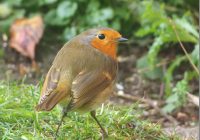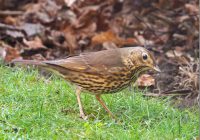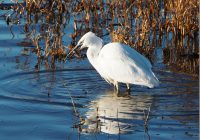Dr Phil Smith’s Wildlife Notes
January 2019
A gloomy month, January was dominated by thick cloud and poor visibility. Persistent high pressure meant hardly any rain in the first couple of weeks, continuing last year’s dry theme. Overall, measurable rain fell on 11 days, though only 29th produced a reasonable soaking. The water-table rose by 12cm at my monitoring point at the Devil’s Hole, but the dune-slacks here remained dry, the water level being 30cm (a foot) lower than at the same time last year. Although there was a cold snap latterly, the early part of January was relatively mild, the first Snowdrops appearing along Range Lane, Formby, on 15th, becoming abundant by the end of the month.
As usual, it was a relatively quiet period for wildlife sightings, not helped by the dark conditions that did not encourage me to venture outdoors much. At least I had my garden birds with a regular flock of about a dozen House Sparrows, several Starlings and daily visits from a splendid Song Thrush as well as the usual Blackbirds, Robins, Blue Tits, Great Tits,etc.
I don’t expect to see insects at all in January but my routine trip to the Devil’s Hole on 1st was enlivened by a swarm of winter gnats. Members of the family Trichoceridae, the males of these non-biting midges perform courtship dances in sheltered spots to impress their mates. Their larvae feed on decaying vegetation, thereby doing a useful job, as indeed do most of the 7000+ species of flies found in Britain.
Several visits to Marshside produced close encounters with various waders and ducks, the latter already in full breeding plumage. Up to 25 elegant Pintails were off the Hesketh Road viewing-platform, together with about 70 Tufted Ducks and a rather elusive young male Scaup. Further north, opposite Crossens Sewage-works, flocks of colourful Wigeon and Teal foraged near to the coast-road, having become accustomed to the traffic noise. Here, an area of saltmarsh churned up by cattle attracts wagtails and pipits, though they are not always present. Happily, my visit on 20th coincided with 23 Pied Wagtails, nine Meadow Pipits and a superb Water Pipit. This scarce winter-visitor from the mountains of central and southern Europe is more reliably seen at this spot in March. Although too distant for a decent photograph, it gave good views through my telescope.
Long cold watches across the endless Crossens saltmarshes were rewarded by occasional views of three magnificent Hen Harriers, a “ring-tail” female and two males in their ghostly grey plumage. A Merlin zipped past while a Short-eared Owl flapped slowly along the marsh edge. A Stonechat added to the interest and a Peregrine sat on a post in front of the nearby RSPB Marshside hide.
Another good birding spot is the 77 ha Lunt Meadows Nature Reserve, recently developed by Lancashire Wildlife Trust, whose staff are currently working on a Management Plan. Acting as flood storage for the adjacent R. Alt, this superb wetland has several large water-bodies, fringed by rushes and reed-beds, the latter mostly derived from plantings. It already has a reputation for wintering birds, including Bitterns and Short-eared Owls. A visit on one of the rare calm sunny days late in the month reminded me that I should go more often. As I arrived, the piping calls of Teal filled the air. A tour of several newly constructed hides provided excellent views of water-birds, including a Little Egret which caught a fish. A Buzzard perched on a fence post and, although no owls turned up, it was an enjoyable trip to an inspirational place. I even recruited a new volunteer for the “Buckthorn Bashers”!
The “Bashers” met twice during the month; first, 12 of us cleared Sea Buckthorn regrowth from slack no. 44 in the frontal dunes north of Sands Lake, Ainsdale. This site is a long walk from the carpark, so Green Sefton kindly provided transport along the beach and back again. Because a high spring tide prevented beach access, our second event was a “Buckthorn Burn” to get rid of material cut in October near Sands Lake. This time we had 14 participants, supervised by Andrew Hampson of Gems in the Dunes. As well as a lot of buckthorn, we burnt a big pile of willow cuttings produced by the Wood Allotments Association. This is a new project developed by The Mersey Forest, enabling woodland owners to engage with local communities and manage their woods to produce logs for wood-burning stoves. In this case, it was an opportunity to cut back dense Grey Willow bushes that have invaded flower-rich dune-slacks at Ainsdale. Other works on the coast by this group are in the pipeline. These activities were part of 2018’s Year of the Volunteer, involving 76 events on the Sefton Coast with about 2300 participants, who contributed over 5200 hours of their time. The Liverpool City Region is promoting 2019 as the Year of the Environment, lots of related events being planned.




